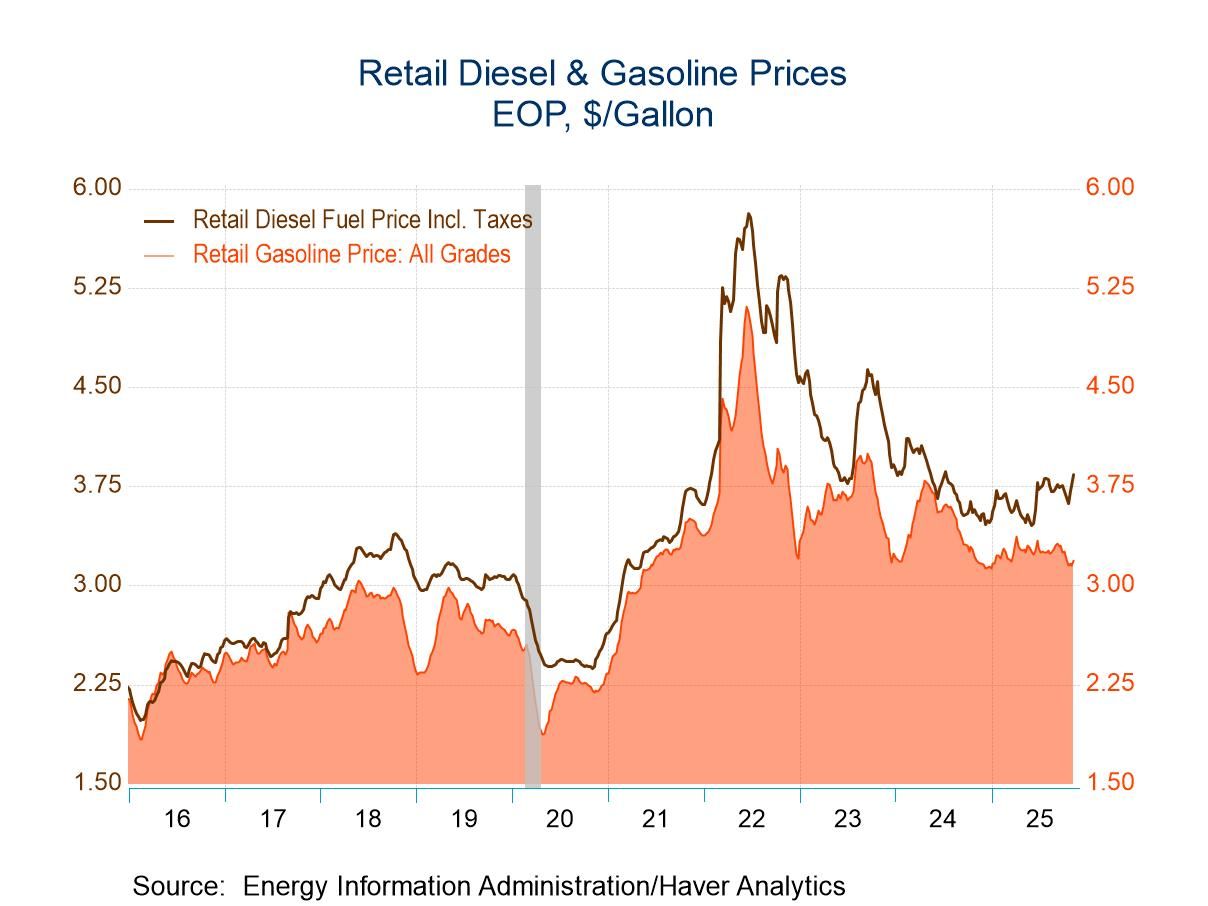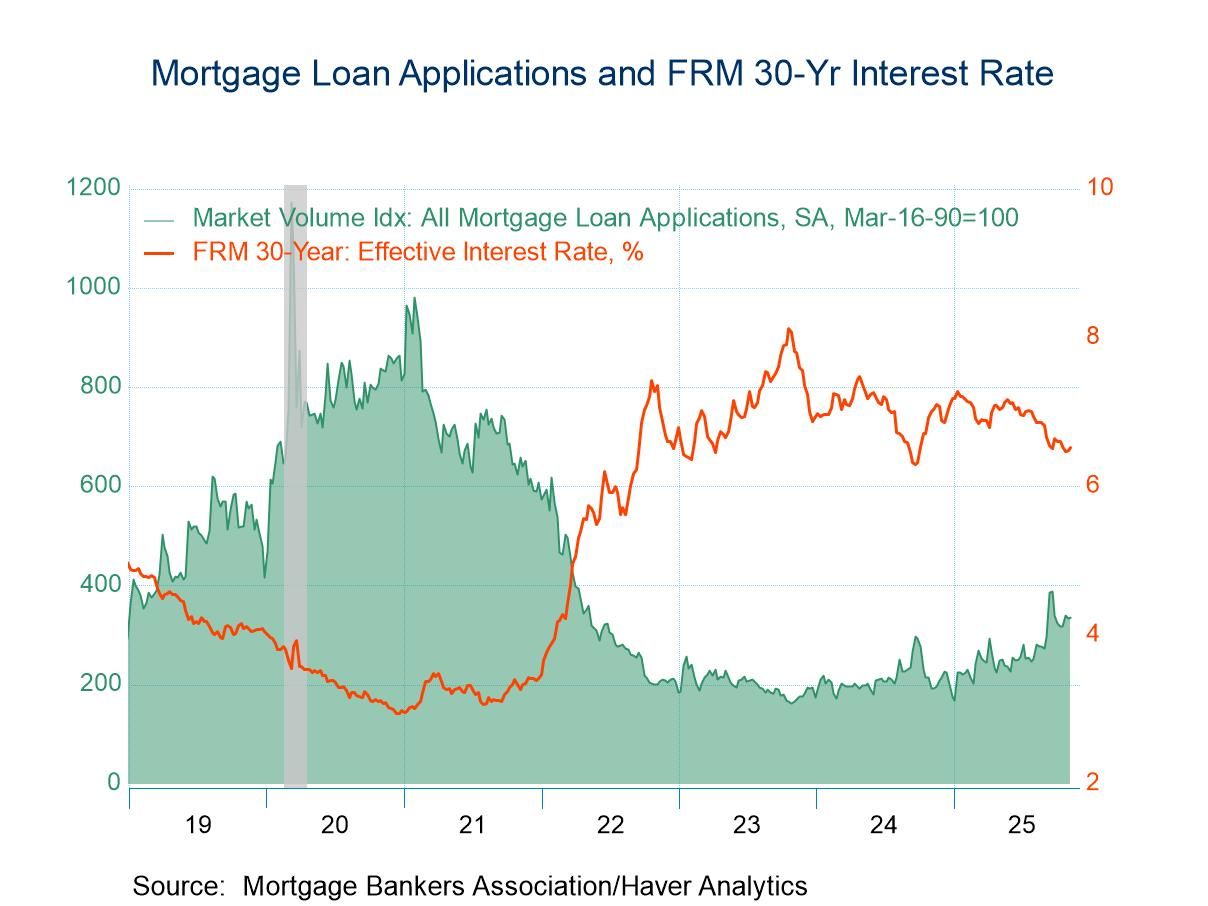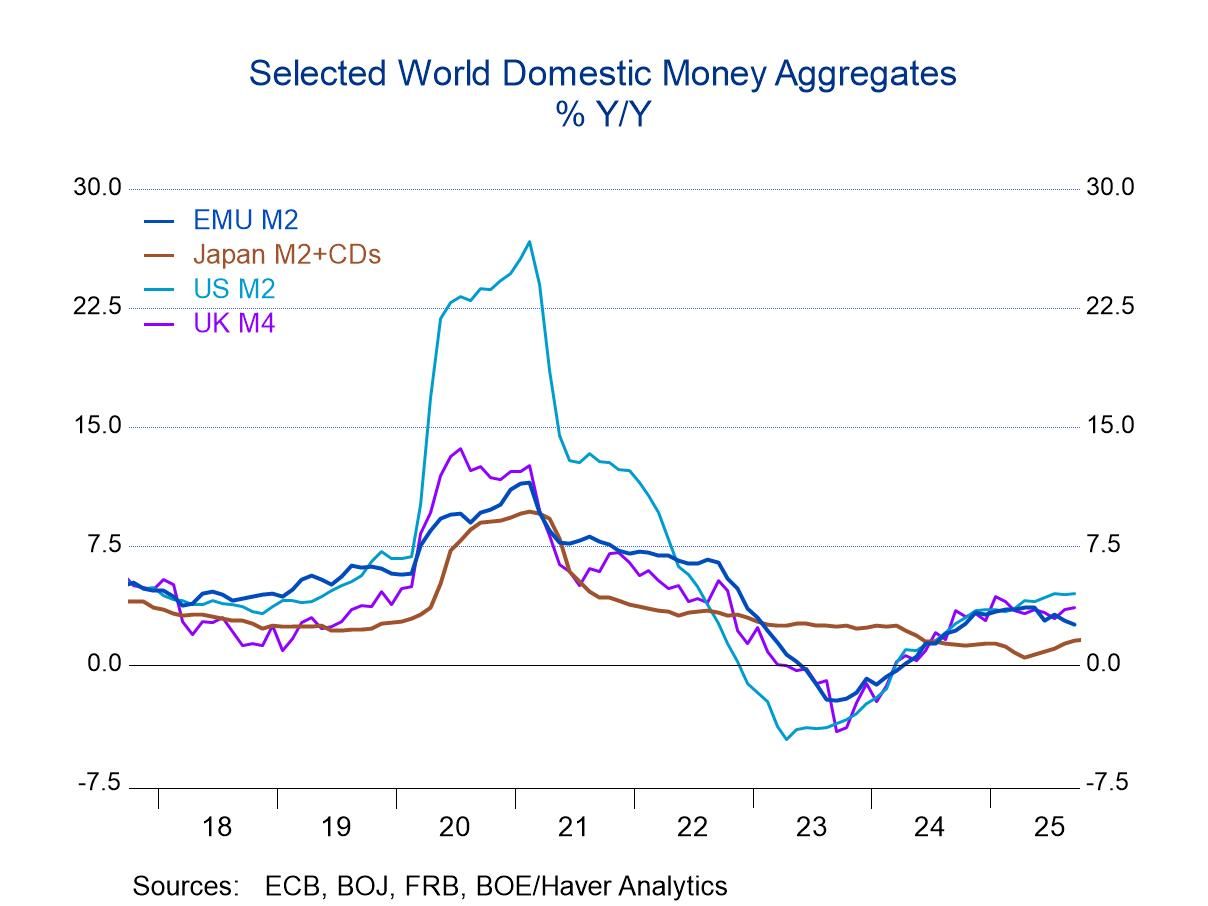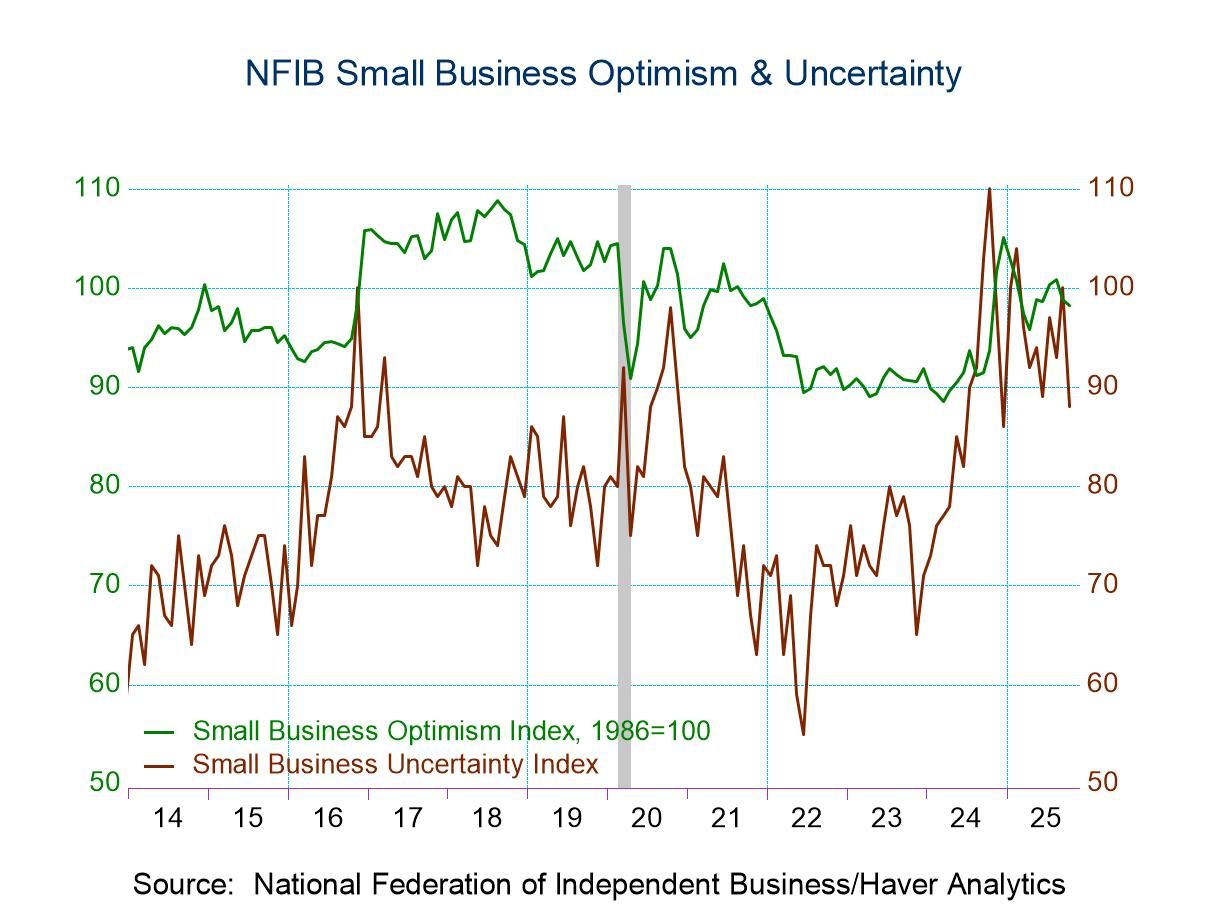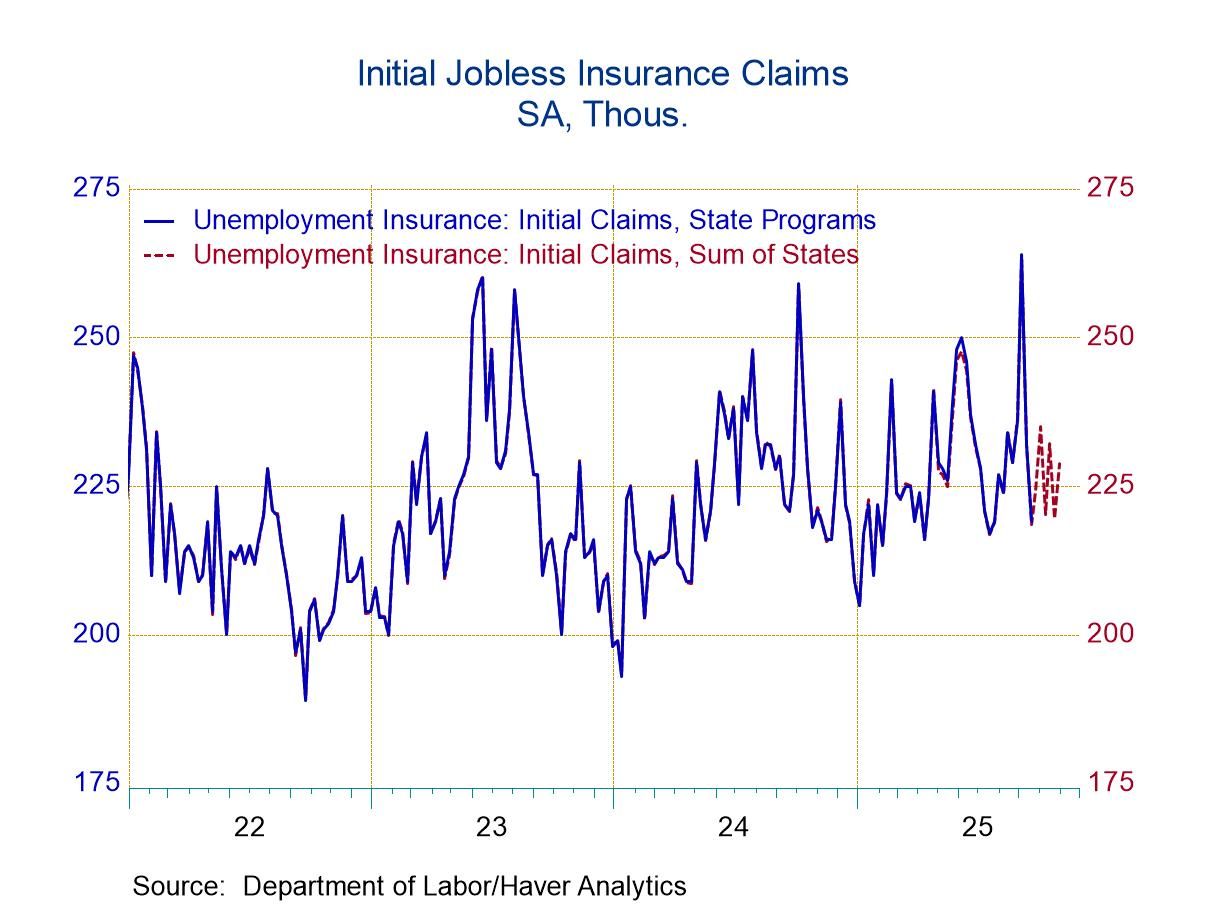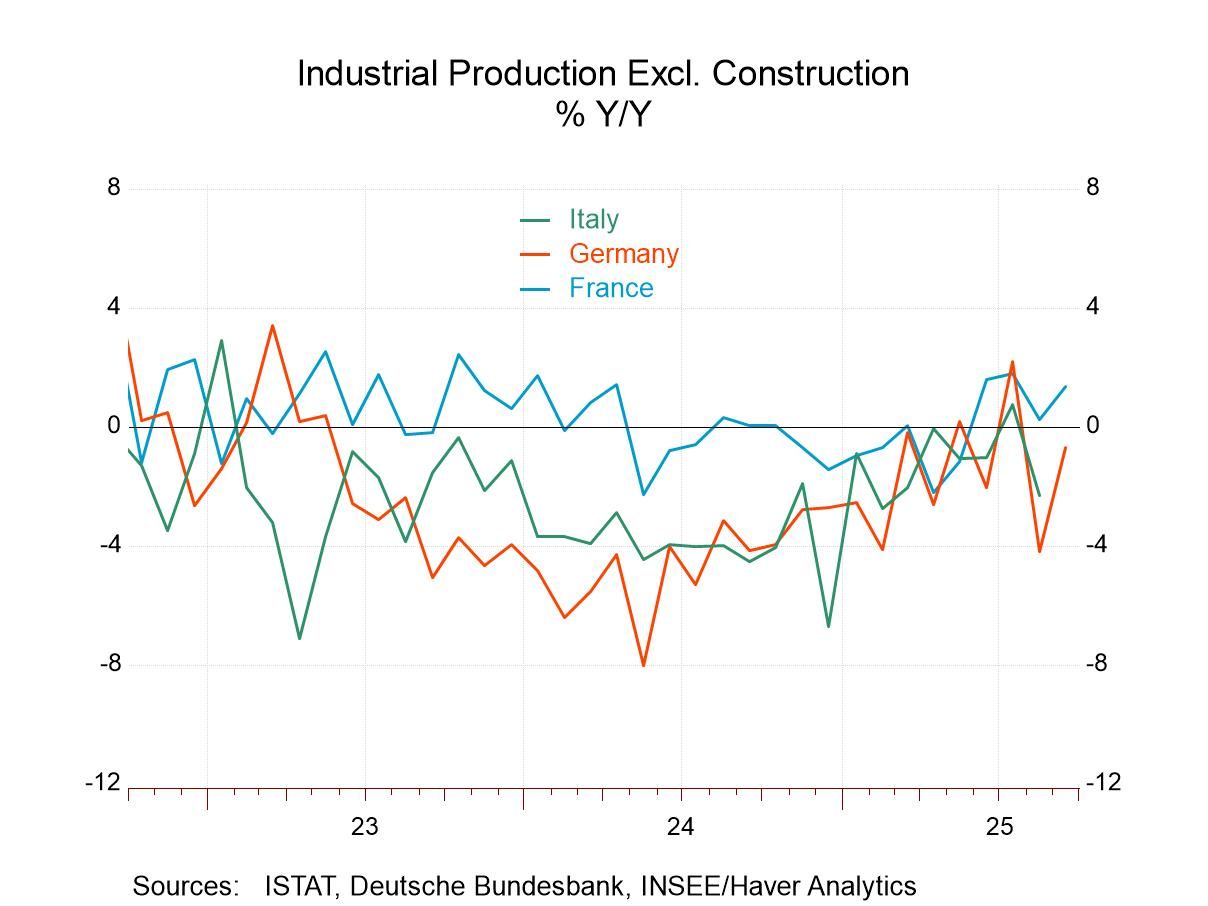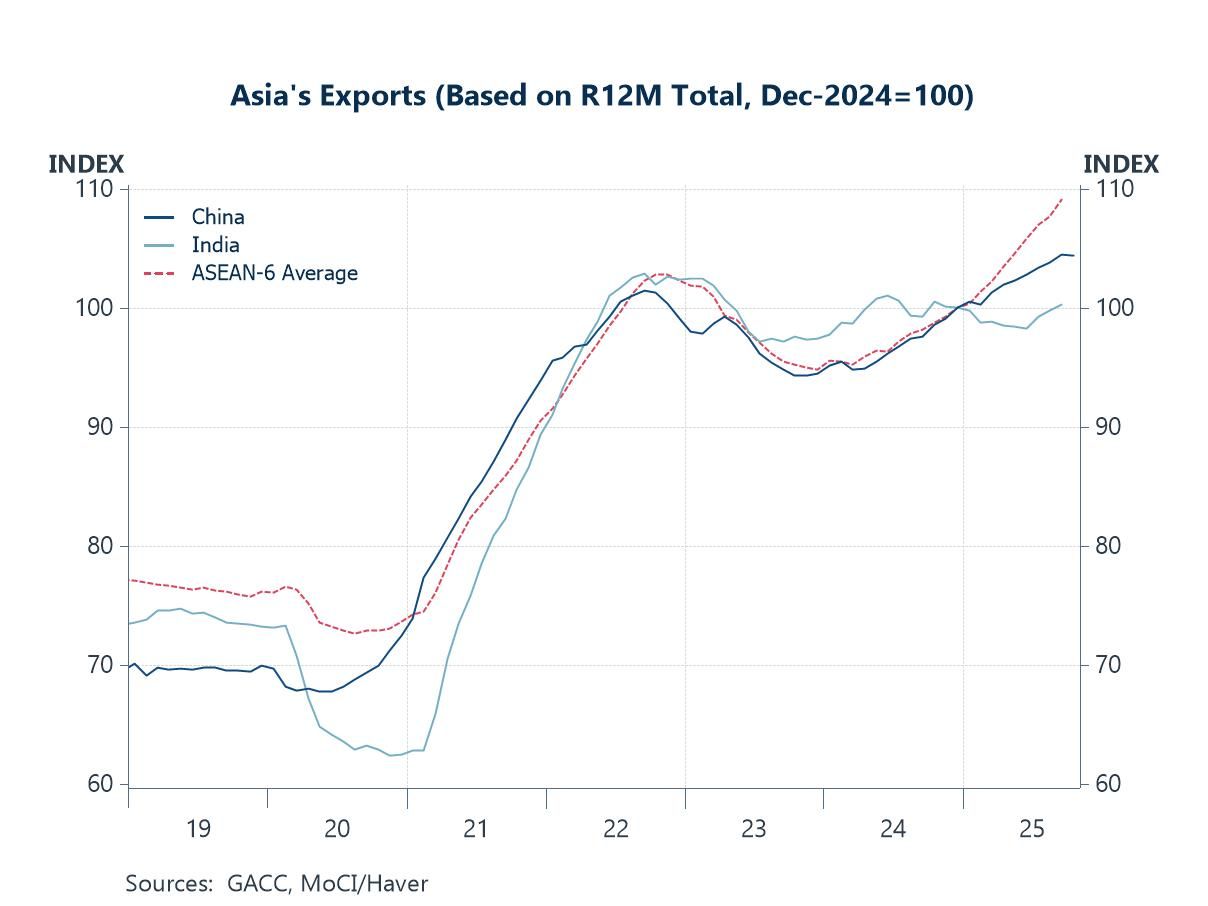- Gasoline prices rise to four-week high.
- Crude oil prices decline.
- Natural gas prices move to highest level since April.
- Demand for gasoline & all petroleum products falls.
- USA| Nov 12 2025
U.S. Energy Prices Remain Mixed in Latest Week
by:Tom Moeller
|in:Economy in Brief
- USA| Nov 12 2025
U.S. Weekly Mortgage Applications & Interest Rates Edge Higher
- Mortgage interest rates rise to three-week high.
- Purchase loans surge but refinancing declines.
by:Tom Moeller
|in:Economy in Brief
 Global| Nov 12 2025
Global| Nov 12 2025Global Money Supplies Deliver Growth-Rate Plateau
Global money supply growth boomed during COVID. Then growth ‘busted,’ decelerating sharply with the United States, the United Kingdom, and the European Monetary Union all showing monetary contraction to some degree throughout 2023. The only country to buck this trend was Japan which had a more modest boost in money supply during COVID and then more modest growth rates that decelerated and continued to gravitate toward near zero growth, until recently, when Japanese money supply started to accelerate very slightly.
Euro Area Recent trends show nominal money growth in the euro area decelerating slightly from a 2.5% growth rate over 12 months to growth rates around 2% or a bit lower over three months and six months. Monetary union private credit has also decelerated from a growth rate of 2.4% over 12 months to 1.7% over six months and to a 1.3% annual rate over three-months.
United States, United Kingdom, and Japan Nominal money supply growth in the U.S. remains fairly steady, growing 4.5% over 12 months and an annual rate of 5 to 5.4% over three months and six months. The U.K. nominal money supply growth is 3.5% over 12 months, 2.8% at an annual rate over six months and 3.6% at an annual rate over three months. Japan's M2 plus CDs has been stepping up its growth from 1.6% over 12 months to a 2% pace over six months to 4% at an annual rate over three months. Nominal money supply growth is mostly fluctuating between steady and stronger across these monetary center countries.
Real balances in EMU Real money balances, however, are looking significantly weaker. In the European monetary Union, real M2 grows 0.3% over 12 months and then its growth rate slips to -0.6% at an annual rate over both three months and six months. Private credit in the euro area rises by 0.1% over 12 months, declines by 0.5% at an annual rate over six months, and declines at a 1.3% annual rate over three months. Real credit is weakening.
More real balances In the U.S., real money supply growth is fluctuating, growing at 1.4% over 12 months, stepping up to 2.3% over six months and back to a 1.4% annual rate over three months. U.K. real money balances are simply shrinking at a -0.6% annual rate over 12 months and a -0.7% annual rate over three months. In Japan, real money balances are actually accelerating; real money growth is -1.3% over 12 months, which rises to plus 0.4% over six months with an annual rate of 2.9% at an annual rate over three months.
- USA| Nov 11 2025
U.S. NFIB Small Business Optimism Index Slips in October
- Inventory, economy & employment concerns weigh on optimism.
- Percentage of respondents raising prices moves down; price expectations ease.
- Concerns about quality of labor surge but labor cost worries recede.
by:Tom Moeller
|in:Economy in Brief
 Global| Nov 11 2025
Global| Nov 11 2025ZEW Expectations Weaken Mildly
Macroeconomic expectations in the ZEW survey backtracked slightly in Germany while improving slightly in the United States in November. The economic situation improved slightly in the euro area and Germany while backtracking in the United States. That's the assessments of the current economic situation and expectations for Germany or the EMU that are moving in different directions in the U.S. and in Germany or in the U.S. vs. the European Monetary Union in November.
Inflation expectations backed off across the board easing slightly in the euro area, Germany, and also in the United States. While that happened, expectations for short-term interest rates became less focused on rate cuts in the euro area and slightly less tilted toward the expectation for rate cuts in the U.S. as well. Long-term rate expectations receded somewhat in both Germany and in the U.S. in November by small amounts. Stock market expectations picked up in the euro area, Germany, and the U.S., and in most cases, somewhat significantly.
The queue standings The queue standings are ranked standings of these various metrics, and they tell a clear story of how the ZEW experts see current conditions and policy tradeoffs. The euro area has an economic situation where the queue standing is at its 51st percentile, slightly above its historic median (on data since the early 1990s). However, Germany and the U.S. have very weak percentile standings with Germany in its 14.5 percentile and the U.S. in its 35th percentile. Macroeconomic expectations, however, find Germany at a solid 63.6 percentile while the U.S. is at a 23.3 percentile. ZEW experts are far more upbeat on prospects for German recovery right now than in the United States – and that seems odd to me with a lot of fiscal stimulus in train in the U.S. and tons of ‘AI’ investment.
Inflation expectations are high in the U.S. at an 85.5 percentile standing, well above the historic median, and clearly showing threatening conditions. This compares to a 30% queue standing for the euro area and Germany.
Short-term rate expectations are significantly below the median for both the euro area and the U.S. with the euro area at a 26.8 percentile and the U.S. at a 9.3 percentile standing. Long-term rate expectations have Germany at a 43-percentile and the U.S. at a more similar 35-percentile. Stock market expectations are fairly similar across the lot with the euro area at a 38-percentile standing, Germany at a 35-percentile standing and the U.S. at a 38-percentile standing.
- Increase in initial claims reverses most of earlier decline.
- Continuing claims continue to increase.
by:Tom Moeller
|in:Economy in Brief
- Europe| Nov 10 2025
Production in a Gradual Recovery in Europe Despite Recent Setbacks
Industrial production for the European Monetary Union (EMU) is not yet available for the union as a whole; however, a number of European countries have reported production, and they give us a good sense of what's happening. In September, among the 13 European countries that reported in the table, all but four of them showed increases in industrial production. Declines were posted in Ireland where production fell by 9.4% in one month, Luxembourg where it fell by 6.1%, Malta where it fell by 1.7%, and in Finland where it fell by 0.4%. In the remaining nine countries, production increased. The median increase for monetary union members in the table was a rise of 0.8% month-to-month. 45.5% of the reporters in the monetary union showed production acceleration.
In August, there were 5 European members with production decreasing. Among European Monetary Union members, the median was a decline of 0.5% with 46.2% of the reporters showing output accelerating on the month. July had been a much worse month with 8 reporting European countries showing declines and with the monetary union median showing a decline of 0.3% and only 38.5% of the reporting EMU members showing output accelerating month-to-month.
There has been gradual moderate improvement in these monthly statistics both in terms of improvement in the median and improvement in the breadth as output has accelerated, with a step back in August.
Looking at the sequential data that compare three-month results to six-month results to 12-month results, we see a median annualized increase of 2.9% for output across monetary union members over three months; that's up from 0.8% over six months and compares to a 2.1% increase for monetary union members over twelve months. The breadth of increase over the period is above 50% on all the horizons and it's fairly steady over three months and six months at about a 54-percentile standing.
September data conclude the results for the third quarter. In this quarter-to-date calculation, 6 of the 13 reporters in the table shows output declining in the third quarter. Monetary Union members generate a median increase of 0.3% in terms of annualized quarter-to-quarter industrial output changes. The pattern and the monthly data seem to be slightly stronger than what we see in the quarter-to-date.
The final column of the table presents the queue standings that calculate the positioning of the year-over-year growth rates across country-reporters among growth rates back to late-2007. Ranked among this cluster of growth rates, only five of the current year-over-year rates stand at levels that are below their median growth rate for the period. Countries with below median growth rates (below a standing of 50%) for industrial production growth are Austria, Germany, Finland, Luxembourg, and Malta. Among these, only one belongs to the four largest economies in the monetary union—Germany, which is also the largest of them. Germany has the standing only its 39th percentile. The unweighted median ranking for the group of monetary union economies is at 57.3%, above the 50% mark and therefore above the historic median.
The industrial production data for the monetary union in September is somewhat encouraging but certainly not crystal clear. There continues to be a lot of weaknesses displayed in the data. While the aggregate ranking is above its historic median, it's not above it by very much and clearly the growth rates are still relatively weak. There still is not a clear trend of acceleration in the group. However, what's lacking in the data is any sign of real deterioration. There clearly is weakness across countries but not a sense of deterioration. The best news in the report may be that there's not any really bad news.
 Asia| Nov 10 2025
Asia| Nov 10 2025Economic Letter from Asia: As the Dust Settles
This week, we review key developments across several Asian economies as the year nears its close. On balance, many of investors’ and policymakers’ worst fears did not materialize. Despite US tariffs, regional exports have shown resilience (chart 1), partly supported by stronger intra-Asia trade, even as exports to the US declined in some cases.
In China, factors including importer front-loading, stronger exports to non-US markets, and government efforts to boost consumption—albeit with potentially one-off effects—have kept the economy on track to meet its 5% growth target this year (chart 2), barring a substantial slowdown in Q4. In Japan, political uncertainty has eased following Prime Minister Takaichi’s rise, though her pro-growth, pro-loose monetary stance has contributed to further yen weakness (chart 3). India, while still likely Asia’s fastest-growing major economy this year, has seen trade setbacks (chart 4) as US–India discussions continue, though recent progress suggests a deal may be near.
However, not all developments in Asia have avoided worst-case outcomes. For example, the Philippines, which has already been hit by a string of storms this year, continues to reel from the effects of Typhoons Fung-wong and Kalmaegi. These storms have highlighted corruption in the Philippines’ flood control systems, rattling investors and pressuring the peso (chart 5), in a manner reminiscent of the rupiah’s decline during Indonesia’s political turmoil earlier this year. In Thailand, political uncertainty continues ahead of general elections eyed at next March, while the expected full return of Chinese tourists has yet to materialize (chart 6).
Trade in Asia For Asia, the year has ultimately not played out as bleakly as investors once feared, particularly on the trade front. Despite US President Trump’s tariffs and a persistent backdrop of uncertainty, export performance in several Asian economies has proven more resilient than expected. This is most clearly reflected in export growth readings for China and key Southeast Asian economies (chart 1), which have remained firm—and at times exceeded expectations—even as China’s shipments to the US fell sharply. Much of this resilience reflects a redirection of exports toward other markets, often within the region. India, however, has seen more limited gains, with exports in US dollar terms struggling to materially surpass last year’s levels.
- of2681Go to 8 page


